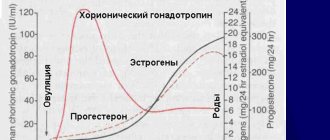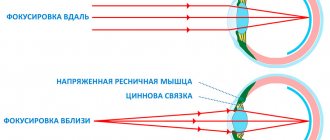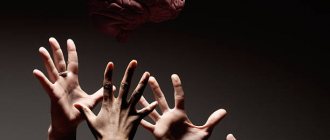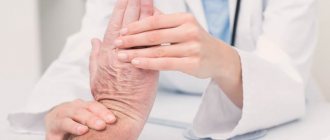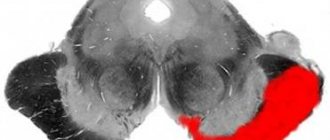Opsoclonus-myoclonus syndrome (OMS) is currently a rare and poorly studied serious neurological disease from both a medical and clinical-psychological point of view [1, 2].
Among the neurological manifestations of compulsory medical syndrome, the central place is occupied by non-systemic dizziness, unsteadiness of gait, frequent falls, tremors of the head, torso, arms and legs, and impaired muscle tone. Characteristic signs of the disease are the phenomena of opsoclonus and myoclonus. Opsoclonus is characterized by involuntary, chaotic, multidirectional saccadic eye movements with horizontal and vertical components. Myoclonus refers to polymorphic myoclonus in the form of short, jerky muscle movements of small amplitude. These manifestations are observed mainly in the muscles of the eyelids, lips, trunk, and proximal limbs. The disease can be mild, moderate or severe, but in any case, the motor skills achieved by the child before the disease regress quite quickly. In approximately 2/3 of patients, the course of the disease is chronic and recurrent.
Patients also have psychological disorders [3, 4]. We are talking about the characteristics of the cognitive and emotional development of children with compulsory medical conditions, the characteristics of their behavior and difficulties in developing speech. Emerging disturbances in mental development can be expressed to varying degrees. In some cases, this is a deficiency of certain functions, which allows the child to remain within the boundaries of normative development, in others - a high degree of their violation, leading to total underdevelopment.
The etiology and pathogenesis of the disease remain poorly understood. The number of studies [1, 2, 5, 6] devoted to compulsory health insurance is small, exploratory in nature, generating more questions than answers. Paraneoplastic genesis (the initial development of a tumor of the sympathetic nervous system), parainfectious damage (a consequence of a previous respiratory or some viral disease) and a post-vaccination complication are considered as possible causes of CMS. It is also assumed that the main damage to the health of children with CMS may be caused by neuroinflammation associated with the uncontrolled functions of immune B cells, which may cause a violation of tolerance and the production of autoimmune antibodies.
Certain difficulties have also been identified with regard to the timely diagnosis of compulsory medical syndrome due to the fact that in at least 20% of cases the manifestation of the disease has a specific and atypical picture. In many cases, it is mistakenly classified as one of the diseases with a similar clinical picture (encephalitis, Guillain-Barré syndrome, etc.). There are difficulties associated with determining the desired treatment regimen, assessing the dynamics of the course and prognosis of the disease.
The onset of the disease, as a rule, occurs gradually, but over a relatively short time: the child develops and intensifies ataxia and tremor throughout the body, and rare uncoordinated movements occur. He quickly loses the ability to maintain balance and walk independently, use a spoon and other familiar objects, drink from a mug (if he knew how to do this before the onset of the illness). Manifestations of chaotic movement of the eyeballs (opsoclonus) begin to be periodically observed. Along with this, twitching of the tongue and a violation of the ability to fully pronounce the words already available to the child often occur. The patient's mental state during this period is characterized by unabating severe crying, which cannot be calmed by conventional means, sleep disturbances and a lack of periods of quiet wakefulness. Sometimes there is apathy, loss of interest in the environment, gaming activities and communication. Dysphoria in relation to loved ones, especially the mother, is characteristic.
Painful sensations create for the child a situation of extreme destabilization, disintegration of the surrounding reality, forcing him to look for physical support and lie down. The disease plunges him into a state of extreme bodily discomfort, regressive helplessness and overwhelm with anxiety.
During follow-up studies aimed at assessing the development of the disease, difficulties in learning and behavior were noted in such children. Thus, according to the results of a follow-up study conducted in Great Britain [6], only 1/3 of 101 patients under observation did not have difficulties in cognitive functioning, which allowed some of them to even receive higher education. In the long-term period, the majority of patients had speech and intellectual disorders of varying severity. Statistically supported studies [7–9] have shown that neurological symptoms in combination with deviations in cognitive development are observed in approximately ½ of patients with compulsory medical syndrome. At the same time, disturbances in cognitive development and behavior more often occur in cases of earlier onset of the disease and a large number of its relapses.
The number of recurrent episodes may be a significant factor for the cognitive, emotional and mental development of children in general, since it indicates the severity of the disease (severity of neurological symptoms) and the duration of exposure to the pathogenic cause [10]. It is important to take into account that, along with the main developmental disorders, specific functional rearrangements are also formed, the structure of which includes secondary and tertiary compensatory components [11-14].
In terms of the above-mentioned features of the disease, a very urgent task is to analyze the nature of the child’s mental development depending on his age at the onset of the disease. The period of ontogenesis, which marks the onset of the disease in pediatric neurology, is of particular importance, since each age has its own characteristics in terms of resistance, sensitivity and vulnerability to harmful influences. The study of this issue in clinical and psychological studies is traditional for a number of neurological diseases, however, in relation to patients with compulsory medical syndrome, the results are not yet sufficient, given the low frequency of the disease in the population.
The purpose of this study is to study the mental development of children of different ages with compulsory medical conditions depending on the age of onset of the disease.
Clinical picture of the disease
Opsoclonus is characterized by motor disturbances in the oculomotor system. During wakefulness and sleep at night, patients actively move their eyes in different directions. Often opsoclonus is combined with irregular twitching of the limbs.
The disease is based on organic brain lesions (neuroblastoma, brain tumors, encephalopathy).
The syndrome can have an undulating course, with periods of exacerbations and remissions. It is more often diagnosed in childhood; adults are less susceptible to it.
Myoclonus (from the Greek “muscle cramp”) is hyperkinesis, which is sudden, jerky, very short paroxysms of involuntary muscle contraction due to nervous excitement. Myoclonus is often compared to an electric shock [2].
Myoclonus is a single hyperkinesis. As a rule, a series of myoclonus - myoclonus - is observed in the clinic. The word “myoclonus” is correctly used when talking about myoclonus as a syndrome. When describing the neurological status, myoclonus means a single hyperkinesis, myoclonus means repeated serial myoclonus [11].
A separate type of myoclonus in the form of rhythmic twitching of a limb against the force of gravity is called asterix. Asterix is characteristic of Angelman syndrome, in which it was first described by Adams and Foley in 1949. In our time, the term “Asterix” has given way to the term “negative myoclonus” (Shagani, Young, 1976). A characteristic feature of negative myoclonus is that the period of muscle tension is much shorter than the subsequent period of relaxation.
Myoclonus is very common in children, but its pathogenesis is not entirely clear. This makes myoclonus one of the most mysterious syndromes in neurology.
Classification of myoclonus
Currently, there are several dozen classifications of myoclonus, and they are constantly being revised. Some of the classifications are presented in table. 1.
| Table 1 |
It shows that many classifications are distinguished by the principle of their construction.
Etiology of different types of myoclonus
Physiological myoclonus
- involuntary shudders that accompany normal motor activity.
Myoclonus after exercise
: short-term muscle contractions of spinal origin, resulting from increased excitability of the segmental motor apparatus.
Hiccups
: rapid contraction of the muscles of the diaphragm and larynx, associated with irritation of the lower parts of the trunk, fibers of the vagus and phrenic nerves. A common cause is gastric overfilling; it also occurs with damage to the mediastinum, pericardium, intoxication, or direct damage to the trunk.
Sleep myoclonus
: in children (and adults) when falling asleep, short tremblings of the arms or legs, sometimes of the entire body, are observed.
Benign myoclonus of infancy
(benign non-epileptic infantile spasms): a rarely diagnosed paroxysmal phenomenon during sleep, occurring in healthy children from 3 days of life to 3 years (most often in children under 1 year), provoked by awakening. Characteristic is contraction of the muscles of the trunk, less often the head, in combination with tonic tension of the limbs of varying intensity. Clinically, the condition resembles infantile spasms or tonic reflex spasms of infancy. Main clinical signs: 1) rhythmic myoclonus during sleep, which stops upon awakening, 2) normal EEG during startles. If both diagnostic criteria are presented, the diagnosis is undoubted. However, the condition is often misinterpreted as epilepsy. Unreasonable prescription of antiepileptic drugs leads to sedation and aggravation of myoclonus [4, 6, 9].
Psychogenic myoclonus
: has a psychological background rather than a physiological one, it is a manifestation of the polysynaptic strattle reflex, the arc of which closes at the level of the quadrigeminal. It is more common in women and worsens with anxiety, sleep deprivation, and emotional stress. It is provoked by sudden stimuli (a sharp shout, a flash of light, an unexpected touch). Accompanied by pronounced autonomic symptoms - tachycardia, increased blood pressure, short-term apnea followed by shortness of breath. Electromyographic (EMG) signs: myoclonus lasts more than 70 ms, consists of three phases of activation of agonists and antagonists; latency more than 100 ms.
Essential myoclonus
- by definition, it is an idiopathic condition, occurs sporadically or is inherited in an autosomal dominant manner. Essentially, essential myoclonus is a benign monosymptomatic disease of the extrapyramidal system of unknown etiology with a non-progressive course [1].
Essential myoclonus-dystonia
: a benign idiopathic condition whose gene is mapped to chromosome 7q21-q31.
Benign familial Friedreich's polymyoclonus
: an autosomal dominant condition with onset in childhood or adolescence with myoclonus of the shoulder girdle and proximal limbs. Over time, myoclonus can spread to the distal muscles of the limbs and face. The course is non-progressive.
Familial nocturnal myoclonus
: described by Symonds in 1953. Lugaresi in 1965 was the first to record extension of the thumb, flexion of the elbow, knee and shin on EMG. Repeated stereotypic movements occur every 15-40 s during the non-REM sleep phase. In 90% of cases it is combined with restless legs syndrome. Improves with the use of benzodiazepam and dopaminergic drugs.
Essential myoclonus of the soft palate
: rhythmic (frequency 2 in 1 s) twitching of the velum and pharyngeal muscles, accompanied by a characteristic subjective sensation of a “click” in the ear (simultaneous contraction of
m. tensor veli palatini
).
Reflex myoclonus
: Occurs with sensory stimulation.
Epileptic myoclonus
. Benign myoclonic epilepsy of infancy: first described by Dravet and Bureau in 1981. In some cases, it is provoked by noise and touch. It is characterized by short myoclonic seizures in a normally developing child aged 6 months to 3 years. In 30% of cases, epilepsy or febrile seizures are detected in relatives [9].
Myoclonic encephalopathy of early life (Ohtahara syndrome)
: onset before the age of 3 months, the main type of seizures is tonic spasms, partial seizures and myoclonus are also noted. A typical pattern is “burst-suppression” on the EEG. The prognosis is unfavorable.
West syndrome
: characterized by attacks of the type of infantile spasms, hypsarrhythmia on the EEG, and delayed psychomotor development [5].
Lennox-Gastaut syndrome
(myoclonic-astatic epilepsy): is a combination of atypical absence seizures, tonic seizures, atonic or astatic seizures, mental retardation, and slow spikes and waves on the EEG with onset between 1 and 5 years of age.
Juvenile myoclonic epilepsy
: manifests as myoclonus upon awakening, debuts in adolescents. Myclonias are localized in the extremities, in particular, trembling of the fingers is characteristic. There are also rare generalized clonic-tonic seizures.
Progressive myoclonic epilepsy
: in addition to myoclonus, the clinical picture is also ataxia, which develops by 6-15 years. Death occurs 10-20 years after debut.
Hereditary metabolic diseases
: lysosomal storage diseases, neuronal ceroid lipofuscinosis, sialidoses, mitochondrial diseases (MERRF); cystamine B deficiency, glycogenosis, Lafora's disease, which are often accompanied by myoclonic epileptic seizures.
Epilepsia partialis continua, Kozhevnikov epilepsy, Rasmussen encephalitis
: a special variant of focal epilepsy, manifested by myoclonus.
Angelman syndrome
(karyotype 46 XX or XY, 15p), characterized by mental retardation with autistic and hyperdynamic behavior, dyssomnia, epilepsy, chorea, negative myoclonus and a constant smiling grimace.
Rett syndrome
(typical MECP2 mutation): progressive autism, accompanied by epilepsy, myoclonus.
Symptomatic (secondary) nonepileptic myoclonus
.
It can be observed in metabolic diseases and neurodegenerative pathologies
.
This myoclonus can occur in metabolic diseases such as lysosomal diseases (Gaucher disease types 2 and 3, Tay-Sachs disease type 4, Sandhoff disease, Niemann-Pick disease type C), sialidosis type 2, lipidoses, neuronal ceroid lipofuscinosis, mitochondrial diseases (MERRF), celiac disease. When they talk about neurodegenerations, they mean Hallerwarden-Spatz, Wilson-Konovalov, Lafora diseases, spinocerebellar ataxias, dentatorubropallidoluis atrophy, systemic atrophies, corticobasal degenerations, Huntington's disease, Parkinson's disease, dementia with Lewy bodies, subacute sclerosing panencephalitis, Alzheimer's disease. Myoclonic dystonia: affects the upper extremities more, debuts at 10-20 years of age, dystonia does not occur in all cases. Boys and girls get sick equally often, the course of the disease is benign (autosomal dominant inheritance). With full penetrance of the gene, myoclonus and dystonia are combined with seizures, ataxia, dementia and other neurological disorders. The diagnosis is confirmed by genetic analysis to determine the typical SCGE mutation.
This type of myoclonus can also develop in autoimmune diseases: multiple sclerosis, acute disseminated encephalomyelitis, opsoclonus-myoclonus syndrome.
Opsoclonus-myoclonus
(Kinsburn syndrome): dancing eyes syndrome, or myoclonic encephalopathy of infancy, is characterized by: saccadic movements of the eyeballs (involuntary, irregular, conjugated, in all directions, with impaired fixation), myoclonus of action, involving the muscles of the face, limbs, fingers, and torso. The age of debut is up to 2 years and older. Therapy includes resection of neuroblastoma and the use of antiviral drugs [7].
Infectious/parainfectious
: subacute sclerosing panencephalitis, Creutzfeldt-Jakob disease, viral encephalitis, streptococcal infection.
Endocrine
: hyperthyroidism, hyponatremia, hypoglycemia.
Structural
: tumors, neuroblastomas; palatal myoclonus with damage to the cerebellopontine angle.
Toxic
: poisoning with gases, metals, organic solvents, pesticides.
While taking medications
: anticonvulsants (valproate, carbamazepine, phenytoin, lamotrigine, vigabatrin), antidepressants (amitriptyline, desipramine, serotonin reuptake blockers), antiasthmatic drugs; psychostimulants (amphetamines, methylphenidate, caffeine); hepatotoxic drugs; medications that depress the respiratory center; corticosteroids; amiodarone, acyclovir, bismuth, thallium, anesthetics, opiates, antitumor agents, contrast agents, dopamine agonists (levodopa) and antagonists (neuroleptics).
For systemic diseases
: hemodialysis, renal and liver failure, lung damage, carbon monoxide poisoning, asphyxia, cardiac arrhythmias, trauma, stroke, electric shock.
The results of molecular genetic studies are presented in table. 2.
| Table 2 |
| ]]> |
Epidemiology
It is difficult to accurately estimate the prevalence of myoclonus because it occurs at different rates in different populations. Thus, in the USA, all cases of myoclonus are 1.3 per 100,000 population, in Finland - 5 per 100,000 population. The most common is secondary, or symptomatic, myoclonus, which occurs mainly in Alzheimer's disease and Creutzfeldt-Jakob disease. The corresponding data are given in table. 3.
| Table3 |
| ]]> |
In Alzheimer's disease, myoclonus develops in 40-50% (1150 cases per 100,000 people per year), in corticobasal degeneration - in 50% of cases.
In Japan, the prevalence of juvenile dentatorubropallidolus atrophy is 0.2–0.7 per 100,000 population. In Western European countries, spinocerebellar degeneration is less common, less than 1%. Ethnic predisposition to myoclonus appears to be related to the frequency of occurrence of the allele in the population [3].
Pathogenesis of myoclonus
The mechanism of development of myoclonus has not been sufficiently studied. An imbalance of neurotransmitters (serotonin, GABA2, opiates, glycine, dopamine) and their receptors is assumed, which leads to decreased activity of the sensorimotor cortex, increased sensitivity of sensory systems and disinhibition of the brain stem and cerebellar dysfunction.
According to pathogenesis, cortical, subcortical, spinal and peripheral myoclonus are distinguished.
Cortical myoclonus
, probably occurs when the inhibitory influence of the sensory (postcentral gyrus) or motor (precentral gyrus) areas of the cortex is disrupted. The frequent co-occurrence of myoclonus with epilepsy suggests that they have a common cause. A pathomorphological study of patients with cortical myoclonus revealed gross symmetrical degeneration of Purkinje cells in all lobes of the cerebellum [10], but there is no explanation for this fact yet.
Mechanism of subcortical myoclonus
unknown Its source is in the trunk. The so-called startle syndromes are manifested by increased activity of normal brainstem connections, which reduces inhibitory processes in the spinal cord. The mechanism of startle syndromes is associated with a mutation in the glycine neurotransmitter receptor. In corticobasal ganglion degeneration, myoclonus is associated with damage to the corticospinal tract, indicating a subcortical origin of myoclonus as a result of disruption of the interaction between the sensorimotor cortex and subcortical structures. Secondary or symptomatic forms may be caused by damage to the trunk or superior quadrigeminal.
Spinal myoclonus
occurs in the upper (cervical) segments of the spinal cord. It is associated with a mechanism such as dysfunction of segmental spinal connections. A deficiency of inhibitory glycinergic influence in the spinal cord and the “release” of synchronous motor neurons cause oscillations in the same segments. Vitamin B12 deficiency leads to the breakdown of myelin with the formation of vacuoles in the thoracic spinal cord.
As a result, degeneration of the descending pyramidal and ascending sensory pathways occurs. Simon showed the role of GABA receptors in the degeneration or transmission of sinusoidal oscillations. Almost 16% of patients with syringomyelia have spinal myoclonus and an increase in the H-reflex.
Peripheral myoclonus
develops with damage to peripheral nerves, as a result of a decrease in the role of central inhibition, which leads to pathologically increased susceptibility of sensory spinal centers.
Diagnosis and treatment of myoclonus
With any form of myoclonus, it is important to determine its cause, since treatment and prognosis depend on the cause and location of the lesion (cortex, brain stem, spinal cord, peripheral nerves). During diagnosis, the doctor must answer the following questions: Is myoclonus spontaneous? Where is the focus of myoclonus? Is myoclonus positive or negative?
In the diagnostic process, the myoclonus rating scale (Unified Myoclonus Rating Scale https://www.mdvu.org/library/ratingscales/myo/) is often used. Let us only note that it is not always applicable in childhood.
This scale, in points from 0 to 5, provides a differential assessment of resting myoclonus, reflex myoclonus, action myoclonus, as well as a generalization of functional tests, a general assessment of negative myoclonus, and the severity of negative myoclonus.
Diagnosis of myoclonus during a neurological examination includes a history, clinical examination of the patient and sometimes his family members (with benign myoclonus, subclinical myoclonus can be detected in relatives). If necessary, various additional studies, genetic analysis and computed tomography are prescribed.
During a neurological examination, the following features should be taken into account:
1. Before starting the study, it is necessary to assess the entire neurological status. Since myoclonus can be combined with other hyperkinesis, it is important to note the presence of dystonia, tremor, ataxia, and spasticity.
2. As with other movement disorders, it is important to identify the part of the body where myoclonus is noted: one of the limbs, the neck, the back, the face, or the entire body.
3. It is important to determine whether myoclonus decreases or increases with movement. This can be easily determined by watching a child drink from a cup.
4. Sometimes myoclonus is caused by a sudden sound, touching the forehead or nose.
5. To exclude negative myoclonus (or asterixis), the child is asked to raise his arms and hold them suspended. Sudden muscle relaxation will cause your arms to drop.
6. It is also important to exclude opsoclonus - “dancing” eye movement.
The only clinical characteristic of myoclonus of any etiology is startle. Moreover, it is important to note that with epileptic myoclonus there is a short-term switching off of consciousness, and with non-epileptic myoclonus, a shudder always causes a certain emotional state, the most accurate definition of which is the phrase “panic fear”. Myoclonus of any etiology is always accompanied by a bright vegetative coloring - usually redness of the skin, profuse sweating, palpitations (usually with cardiac arrhythmias) and dyspnea. Moreover, the listed vegetative symptoms are often so pronounced for the patient that they erase the actual fact of myoclonus from memory. Consequently, to diagnose myoclonus and clarify its cause, clinical criteria alone are not enough.
For a long time, the main method for diagnosing myoclonus has been EMG. This method reveals the duration and frequency of myoclonus, the pattern of distribution to other parts of the body (as with propriospinal myoclonus).
In cortical myoclonus, the greatest brain response occurs with electrical stimulation of the hands and feet. This phenomenon formed the basis for recording somatosensory evoked potentials.
In cortical myoclonus, the typical duration of movements is 100 ms, and the distribution is rostrocaudal. With subcortical myoclonus, the duration is less than 100 ms, with distribution in the rostrocaudal direction from the trunk. In spinal myoclonus, focal or propriospinal, the duration is usually less than 200 ms and spreads rostrally and caudally along the spinal cord.
Polysomnography with simultaneous recording of EEG and EMG increases the reliability of the study for determining the location of the lesion. Thus, with spinal myoclonus, EMG changes do not cause changes in the EEG.
Evoked potentials (EPs), motor and sensory, also characterize myoclonus. Motor EPs localize the lesion, sensory EPs identify cortical myoclonus, with typical slowing waves.
However, given the fact that a fair proportion of myoclonus is of epileptic origin, and subcortical and spinal myoclonus is often accompanied by a panic reaction, in our opinion, it is important to carry out simultaneous registration of EEG, EMG and ECG. Moreover, this registration must be long-term in order to record myoclonus, and be accompanied by such provocative tests as photostimulation, voluntary movement and a sharp sound. Therefore, the optimal method is video-EEG monitoring with simultaneous recording of ECG and EMG.
After the presence of myoclonus is verified and its nature is determined, the diagnosis is aimed at identifying its etiology. At this stage, poisoning by chemical substances must first be excluded; after this, it is necessary to determine the level of electrolytes and glucose, liver and kidney function, exclude metabolic diseases (screening for hereditary metabolic diseases), exclude degenerative diseases for which treatment has been developed (for example, Wilson-Konovalov disease), exclude an autoimmune process caused by streptococcal infection (anti -streptolysin O).
Since myoclonus can be a symptom of a physical illness, including liver damage or a tumor, it is important to examine the activity of internal organs. For example, with opsoclonus-myoclonus syndrome in children, a computed tomography scan of the chest and abdominal cavities, blood and urine tests should be performed to exclude neuroblastoma. The use of computed tomography (X-ray and magnetic resonance imaging) of the brain allows us to identify tumors, hemorrhages, malformations and other structural lesions of the cerebrum, cerebellum and brainstem. This is especially important in the presence of focal symptoms and suspected epilepsia partialis continua
The child has.
To exclude infectious and parainfectious myoclonus, lumbar puncture is also used.
Often essential myoclonus or myoclonus-dystonia regresses when taking small doses of alcohol. This fact is useful for diagnosis, but, unfortunately, not applicable for treatment.
Genetic studies for myoclonus make it possible to diagnose conditions such as myoclonus dystonia, Huntington's disease, spinocerebellar atrophy, myoclonus epilepsy, and dentorubropallidoluis atrophy.
When diagnosing myoclonus, some other techniques are also used, in particular medication. Thus, manifestations of myoclonus in immunological disorders are reduced when oral corticosteroids are prescribed (prednisolone); intravenous immunoglobulin and plasmapheresis are less effective. For juvenile myoclonus epilepsy, valproates are usually very effective; for cortical myoclonus, valproates, piracetam and lamictal are effective; myoclonus in hypoxia responds to serotonin. Any type of myoclonus is increased when taking carbamazepine (doctors should always remember this).
The onset of myoclonus can be provoked by homeopathy, errors in diet, and long-term use of pharmacological drugs.
When carrying out differential diagnosis for myoclonus, it is important to exclude other movement disorders: tics, chorea, dystonia, but, as a rule, the patient has a combination of these hyperkinesis. Myoclonus is often confused with tremor. Myoclonus should be distinguished from myokymia. Myokymia is slow wave-like twitching of large muscle groups, most often in the face and neck. Myokymia causes disinhibition of the motor nuclei of the brain stem. In clinical practice, it is most difficult and important to distinguish myoclonus from tics.
Non-epileptic myoclonus is treated only if it affects quality of life by limiting daytime activities. Benzodiazepines and valproates are widely accepted in the drug therapy of myoclonus. However, repeated double-blind randomized studies have shown that these drugs do not have a significant effect. Monotherapy and gradual dose titration are desirable. The choice of drug depends on the results of the diagnostic search, taking into account side effects. The drugs of choice for the treatment of myoclonus are: levetiracetam, clonazepam, valproic acid, primidone, piracetam, acetazolamide.
Mechanism of disease development
Opsoclonus is caused by increased production of anti-III antibodies (ANNA-2). Scientists have not yet identified a common cross-reacting antigen. There are a number of diseases that are accompanied by their increase in the body.
- Rhinopathy is paraneoplastic, manifested by blurred vision at dusk, often progressing to complete blindness. Similar manifestations are characteristic of multicellular lung cancer and melanoma growth.
- Lambic encephalitis. It begins with emotional and cognitive disorders: the appearance of anxiety and depressive thoughts, a sharp deterioration in short-term memory.
- Brainstem encephalitis is manifested by attacks of dizziness, speech and swallowing disorders, and hearing loss.
- Motor neuron disease. It is expressed in the appearance of various motor disorders, which is detected in the last stages of the development of malignant tumors, lymphogranulomatosis, and lymphomas.
- Polyneuropathy is symmetrical, distal, sensorimotor. It is a sign of monomelonial gammopathy, multiple myeloma, endocrinopathy, Waldenström's macroglobulinemia.
Causes
Currently, scientists have identified two main reasons that lead to the development of hypnagogic twitches. The first is the natural change between the fast and slow phases of sleep, as a result of which the body awakens. The second group includes the work of the hypothalamus, which controls the body's reaction in response to the natural slowing of breathing and heart rate during sleep. This part of the brain is responsible not only for the functioning of the respiratory and cardiovascular systems, but is also involved in the process of falling asleep.
Features of the disease
Opsoclonus most often occurs in childhood. Most of the recorded cases occurred in the age period from the 1st to the 3rd year of the child’s life. The pathology manifests itself as a paraneoplastic syndrome (i.e. caused by severe viral or bacterial pathologies, toxic poisoning, trauma, tumor development) and idiopathically (without the ability to identify the cause of the disease).
In adults, opsoclonus occurs against the background of oncology of the pulmonary system (small cell cancer), neuroblastoma and other neoplasms.
A characteristic picture of the disease is the presence of chaotic eye movements directed in different directions. These flashes occur abruptly and may be associated with changes in eye fixation. They are accompanied by severe myoclonus (muscle twitching in any part of the body). The syndrome can manifest itself for years and in some cases disappear over time.
Modern medicine considers opsoclonus as an autoimmune pathology. It affects the cerebellar cells. The mechanism of the disease remains unclear. According to recent studies, scientists have found that the impetus for its appearance is the disinhibition of the cerebellar tent nuclei (Kölliker nuclei)
Opsoclonus most often occurs in infectious, metabolic, and paraneoplastic conditions.
Some scientific studies describe the leading role of togaviruses and polio viruses in the development of the disease. In childhood, opsoclonus is caused by the development of tumors of the sympathetic nervous system.
Sleep paralysis
This condition is a violation of the coordinated work of falling asleep and waking up. It is accompanied by panic with lack of air, the presence of fear of death and the development of hallucinations. The development of paralysis is caused by the advance of the brain's work over the activity of the body, which is expressed in the awakening of the brain and all its mental functions from sleep and the lag of motor activity in the process of activation of the body.
Patients explain the development of the clinic with the inability to make movements, the appearance of sensations of the presence of a foreign object that prevents the patient from getting out of bed and does not allow the patient to get up. Depending on the emotional state of the individual, hallucinations may develop. Treatment includes non-drug interventions associated with the work of a psychologist, reducing stress, and including physical activity.
Treatment
Treatment for hypnagogic states will depend on the cause that leads to its development. It is prescribed after the necessary diagnostic studies have been carried out. If there are signs of epileptic seizures that occur during sleep, pathogenetic therapy is prescribed.
Patients are prescribed anticonvulsants from the group of Clonazepam, Carbamazepine or Valproate. The form of release depends on the severity of the twitching; these can be injections or tablets. In some cases, therapy is supplemented with antipsychotic drugs.
Attention! Non-drug methods for any of the forms are recommended to regulate sleep, eliminate overeating and active physical activity before falling asleep.
In case of twitching caused by sleep disturbance due to stress, nervous tension or a certain fear, the patient is recommended to undergo a course of psychotherapy with possible treatment by massage or acupuncture. If there is no effect, antidepressants or sleeping pills are prescribed.
Prevention
There are no specific measures aimed at preventing the development of hypnagogic myoclonus. Doctors recommend adhering to general recommendations that will be aimed at improving sleep, reducing the frequency of awakenings, and limiting overexertion and nervous exhaustion. These events include:
- Normalization of the diet with the inclusion in the diet of a sufficient amount of foods enriched with calcium, magnesium and potassium.
- Avoid drinking alcoholic beverages in excessive quantities.
- Including moderate physical activity in your diet.
- Prevention of hypothermia and inflammatory diseases of muscle fibers.
- Eliminating or minimizing stress and nervous tension.
In the evening, add procedures that will help you relax and improve sleep. These include light massage, bathing with soothing herbal remedies, and aromatherapy.
Diagnostics
To make a diagnosis, the doctor first needs to conduct a conversation with the patient, during which the main complaints, the time and conditions of their occurrence are clarified. When describing the conditions that develop in a patient, it is important to assess the presence of concomitant manifestations, which in some cases are necessary for differential diagnosis. From the medical history, the doctor needs to obtain information about the possible use of medications, the presence of chronic diseases and psychiatric disorders.
Important! The mental state is important not only for the patient, but also for close relatives, since the disease can be genetic in nature.
Information about the psychological state of the patient for several days before the onset of an attack is of great importance. The nature of sleep, intensity of work and relationships with family members or colleagues are clarified.
Why do my back muscles hurt?
Additional methods are used for the purpose of differential diagnosis and exclusion of conditions accompanied by a similar clinical picture. These include:
- Performing a general clinical blood test. The study allows us to exclude the presence of inflammatory diseases.
- Determination of glucose level in blood serum. It is important for the doctor to refute the presence of diabetes mellitus with a possible hyperglycemic or hypoglycemic state.
- Immunological tests. A positive result of the data obtained may indicate damage to the nervous system.
- Computer or magnetic resonance imaging. Its implementation is aimed at searching for pathological formations in the organs of the central nervous system, as well as narrowing of the vascular component.
- Ultrasound scanning.
- Perform an angiographic scan with the addition of contrast agent.
- Carrying out Doppler sonography. The technique evaluates the state of blood flow and determines possible causes of its disturbance. These studies allow you to make the most accurate diagnosis and select the necessary treatment.
X-rays or CT scans are the most effective methods to rule out diseases that cause seizures.
